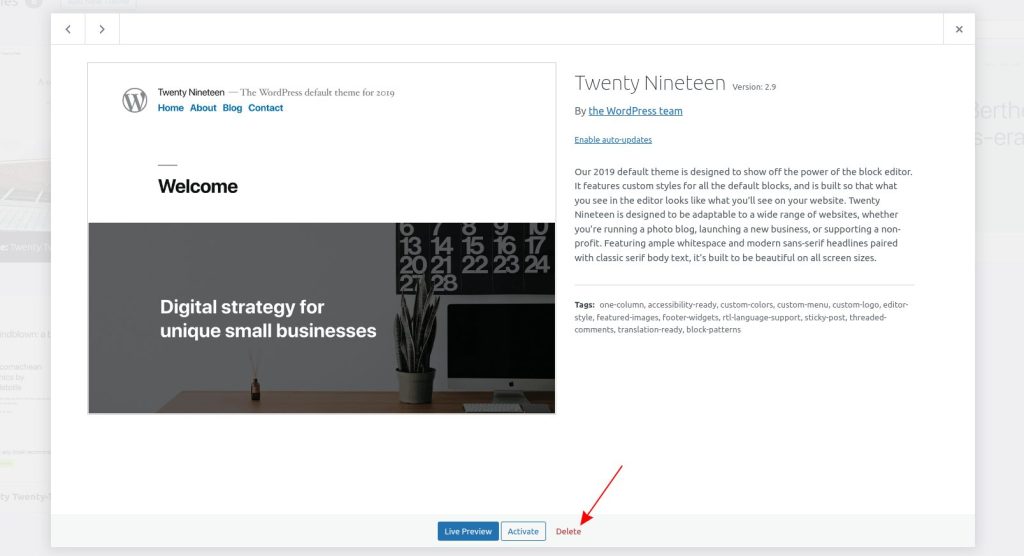When creating a new WordPress site or updating an existing website, it is often common to test different WordPress themes. In quite a few cases, these test objects remain and are not removed, which is bad practice as this can lead to a number of difficulties later on.
In this material, we will look at the reasons why you need to remove unused themes from your WordPress installation and the different methods you can use to do this.
Preparations Before Removing a Theme From WordPress
Before you start deleting themes in WordPress, you must have access to the WordPress admin panel. Editor rights are not sufficient to perform these actions. You therefore need full administrator rights.
It is recommended that you have access to the theme files themselves as well as to the database. Your data is bound to steps that are optional but highly recommended.
Another important step before you start any action is to create a backup of your website. This way, you can be sure that you can restore your website to a working state in the event of a faulty action.
And the third important aspect is determining which active theme to use and which inactive themes to remove. For better visualization, we use in this material:
Active theme: Twenty Twenty-four
Inactive themes: Twenty Nineteen, Twenty Twenty, Twenty Twenty-One
In the WordPress admin panel, open the menu Appearance → Themes

The image above shows how the active theme is displayed. For comparison: On the second Twenty Nineteen theme, we see the "Activate" button, which means that it is currently inactive.
How to Remove a WordPress Theme
Now that we have completed the preliminary steps, let's move on to removing a theme. We have prepared for you three possible options for performing this action:
1. Using the WordPress Dashboard
Delete via the WordPress admin panel.
Access the Appearance → Themes menu again. Click on the inactive theme. In our example, Twenty Nineteen. Once the theme is selected, you will see buttons below its appearance, one of which is called “Delete". You can use it to delete the theme.

2. Using cPanel (or Similar Hosting Control Panel)
Delete via cPanel
Another option to remove a WordPress theme is through the Control Panel's file manager (if available). After accessing the cPanel, you need to open the "File Manager" menu. Navigate to your website directory and then to “wp-content/themes”. There you will also see all (active and inactive) threads that have been posted. You need to select the relevant directory (click once), and the option to delete will be activated in the file manager itself:

3. Using FTP (File Transfer Protocol)
The third way to delete a theme is to use an FTP client, such as FileZilla.
You need to know the correct FTP data, enter it into the respective client, and access the root directory of the website/wp-content/themes. As with the previous option, you will see all templates here. To remove one, right-click on the directory of the theme you want to delete (in our case twenty nineteen) and select the "Delete" option.
Discover how to set up an FTP account for your WordPress site in our step-by-step guide.

Cleanup After Deleting a WordPress Theme
We would like to highlight a few additional aspects that you should check after a theme has been removed. Larger themes often add various additional menus, plugins, images, and more that you no longer need and would be more likely to get in your way in the future. Below we will highlight the following actions:
Deleting Widgets
Removing the unused widgets will help streamline the layout and give your visitors a cleaner, more focused look. It can also help load the site faster, as there is less to load for each page.
To delete widgets in WordPress, start by navigating to your Admin Panel. From there, go to Appearance and select Widgets.
Admin Panel -> Appearance -> Widgets
Deleting Theme-Specific Media Files
This action contributes to reducing the size of your backups. Furthermore, it makes it much easier to find the needed media files, hence increasing workflow efficiency.
To delete media files added by a specific theme, go to the Admin Panel, click on Media, and open the Library.
Admin panel -> Media -> Library
Reassigning Menus
Properly assigning menus to appropriate locations will enhance the navigation of your site so that users can find your content easily. Equally, organized menus contribute to a more professional look and raise the level of user experience on your site.
To edit Menu settings or to reassign Menu locations, go to the Admin Panel, then Appearance, and select Menus.
Admin Panel -> Appearance -> Menus
Why Delete Unused WordPress Themes?
Some of you may wonder why theme deletion should be carried out at all. We focus primarily on the first point, namely:
- Security concerns:
It is very important to understand that even if the theme is inactive, its files can still be used by malicious people. In our practice, we have seen more than one attempt (some of which were successful) to hack through exactly this type of theme. For this reason, you should not forget to remove inactive themes. - Performance optimization:
Everything on a website, even if it is not being used, can slow it down. Extra entries in menus, in the database, etc. have an impact. It may be minimal, but if you have tested many themes, you will eventually notice significant delays. - Reducing clutter:
For one thing, your files are aesthetically arranged, and for another, it would be easier for you to figure out which theme is being used. This eliminates the possibility of a possible error.
Explore our list of top free SEO-friendly WordPress themes to boost your site’s rankings.
Want a Clean WordPress Theme Removal? Trust the WP Experts at Hosting Jump
If you don't want to take risks and rely on professional support and service, then we recommend you get acquainted with our 24/7 WordPress Support service, where you will get everything your business needs. This includes:
- Daily monitoring
- Security settings and protection
- Audit of a slow website
- Configuration of a cache plugin for a super-fast website with LiteSpeed web server
- WooCommerce settings
- WordPress core update
- PHP settings
- Help with working with the admin panel
- Support with Error 500
- And more
Choose the best WordPress support plan for you and your business from Hosting Jump.

Conclusion
In conclusion, we can say that removing inactive themes in WordPress is a step you should not miss. The action is easy to perform, and there are also several ways to do it. Do not skip this step to avoid serious negative effects on your WordPress website.
FAQ
What happens if I delete a currently active theme?
If you attempt to delete a theme that is currently active, WordPress will not allow you to do so. You must first activate another theme to proceed with the deletion. This is an important safety feature to prevent users from accidentally breaking their site by removing a theme that is in use. Always make sure to choose and activate a different one.
What happens to my content if I delete a WordPress theme?
When you delete a WordPress theme, your content remains intact. Themes in WordPress are responsible for how your content appears but do not affect the actual content stored in your WordPress installation. However, if the theme you want to delete has custom settings or modifications, those will be lost once the theme is removed.
Can I delete premium WordPress themes?
Yes, you can delete premium WordPress themes just like you would with free themes. Go to Appearance -> Themes, find the premium theme you wish to delete, hover over it, and click the delete button. Ensure that it is not the current theme in use.
Can I delete a parent theme if I am using a child theme?
No, you cannot delete a parent theme if you are using a child theme, as the child theme relies on the parent theme for functionality. You need to deactivate the child theme first before deleting the parent theme.
What are the steps to delete a child theme?
To delete a child theme, navigate to Appearance -> Themes, find the child theme you want to remove, and make sure it is not active. Hover over the theme and click the delete button to uninstall it.
Will uninstalling a theme affect my WordPress site?
Uninstalling a theme might affect your WordPress site if that theme provides specific functionalities or design elements. Always ensure that you have an alternative theme activated before proceeding with the deletion.
How do I delete themes installed on a WordPress multisite?
To delete themes installed on a WordPress multisite, you need to access the Network Admin dashboard. From there, go to Themes, find the theme you want to delete, and click on "Delete" under the theme details.
What should I do if I want to delete a WordPress theme but cannot find the delete button?
If you cannot find the delete button, ensure that the theme is not currently active. If it is, activate a different theme first. If the theme is a child theme, you will need to delete the parent theme instead.
Can I keep one theme for backup purposes while deleting others?
Yes, you can keep one theme as a backup while deleting others. It is often a good practice to retain at least one default WordPress theme as a fallback in case you encounter issues with your current themes.

